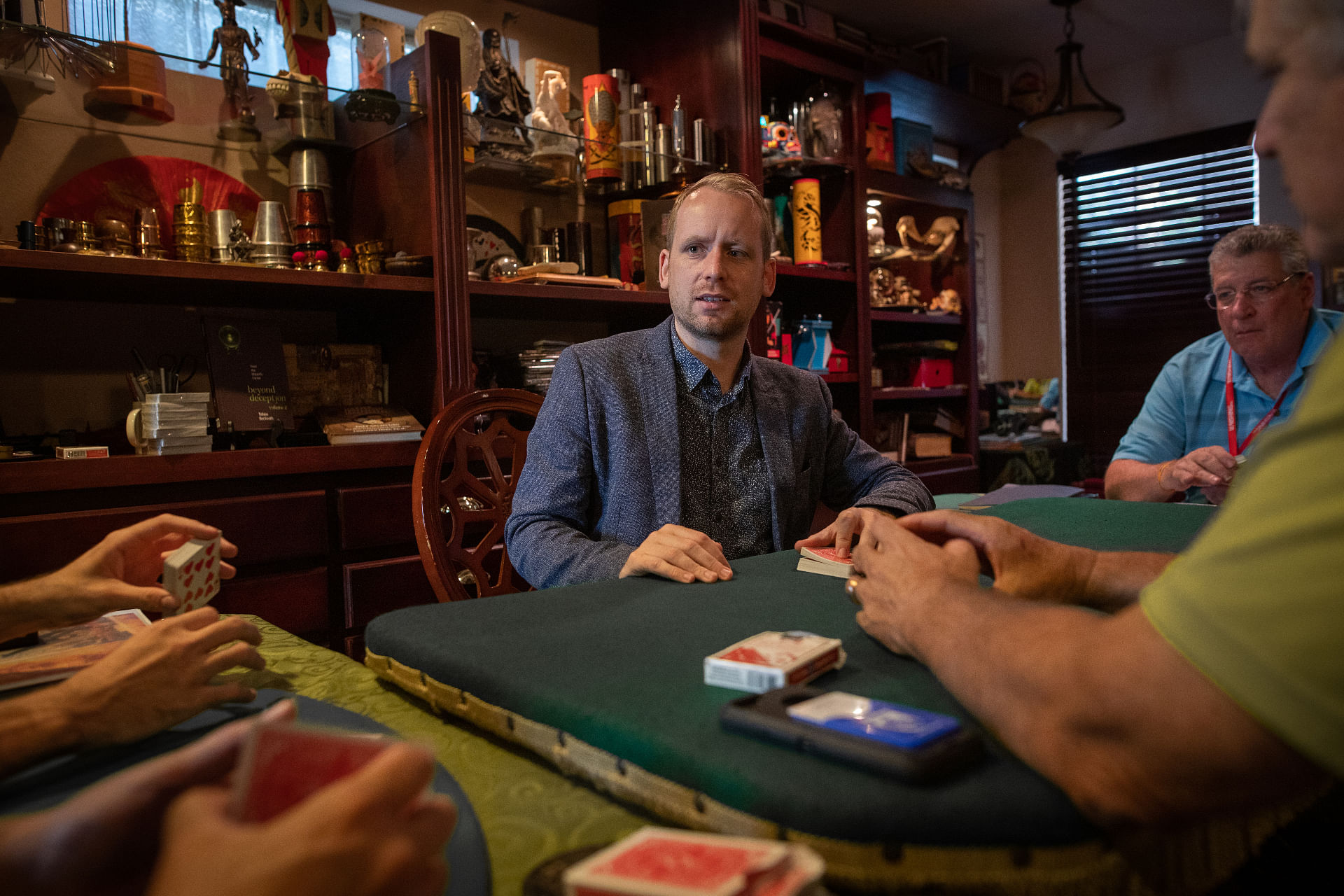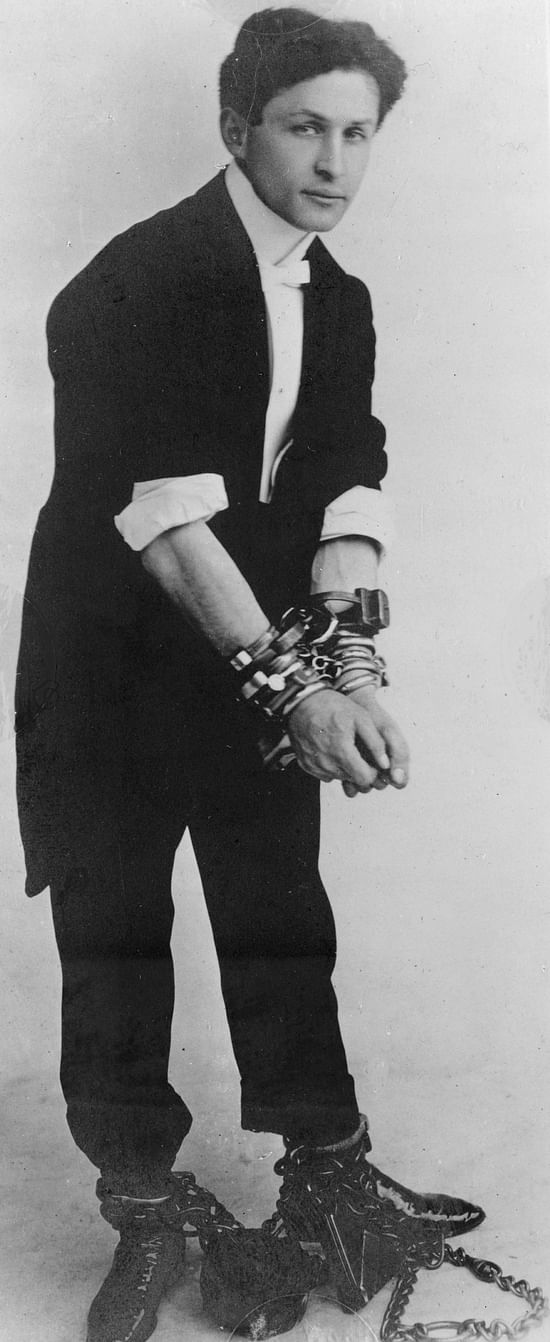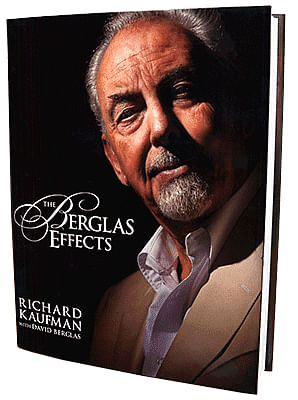5 Intermediate and Advanced Card Tricks Every Magician Should Learn

Triumph
Triumph Card Trick Explained
Triumph is one of the most well-known tricks ever invented. It is beloved for the fact that it is so beautifully simple and direct, yet also incredibly impactful.
The basic Triumph routine involves a playing card being selected and then lost back in the deck. Half the cards are then turned face up and shuffled into the remaining face down pile, creating a chaotic mess of cards facing in different directions. After making a magical gesture, the magician spreads the cards to show that they are now all magically facing the same way, except one card—the spectator’s chosen card.
History of Triumph
The basic idea behind Triumph can be attributed to a mechanical trick deck effect called Inverto that was released by Theodore DeLand in 1914 according to Genii Magazine’s Magicpedia. Over the next three decades, this unique effect inspired many other “reversed cards” and “slop shuffle” style effects.
Finally, in 1946, one of the greatest magicians that ever lived, Dai Vernon (affectionately known as “The Professor”), published his version of a “reversing cards” effect in “Stars of Magic - Volume 2”. This effect not only gave birth to the name Triumph but also introduced the Triumph Shuffle—a special strip-out shuffle where the playing cards are secretly put back in order under the cover of riffle shuffling and cutting the deck.
As The Professor’s version is still used regularly by professional magicians around the world, and has inspired many of the countless variations available today, magicians often credit Dai Vernon as the inventor of Triumph.
Where Can I learn Triumph?
As noted above, Triumph is a super popular card trick that has been evolved by numerous other professional magicians over the years. Here’s where you can learn the original Triumph routine, as well as some of our other favorite variations.
The Ambitious Card
Ambitious Card Trick Explained
The Ambitious Card is an amazing magic trick that should be in the repertoire of any magician. There is a reason it’s taught in basically every beginner magic book like The Royal Road to Card Magic, Mark WIlson’s Complete Course in Magic and Roberto Giobbi’s Card College.
In its most basic form, an Ambitious Card routine features a selected card (which is also usually signed) repeatedly appearing on the top of the deck after being placed in the middle of the deck or somewhere else entirely. Most of these routines generally feature multiple phases that get increasingly more impossible before finally concluding with a surprise ending that features the chosen card disappearing entirely from the deck and reappearing in an impossible location such as an envelope or wallet (typically a special Card to Wallet prop).
While beginner magicians can absolutely perform the Ambitious Card Trick, many intermediate to advanced magicians love this effect because of the versatility it offers. Like the classic cups and balls magic trick, there is a seemingly endless amount of variations and sleight of hand moves that can be implemented. Similar to a jazz musician, many magicians will even improvise certain parts of an Ambitious Card routine based on the audience they’re performing for.
History of the Ambitious Card
 While some credit the first iteration of the Ambitious Card to a book published in 1886 by French Magician Alberti titled Recueil de Tours de Physique Amusante (which was translated a year later into Drawing Room Conjuring by Professor Hoffmann), others believe the Ambitious Card may have first appeared in Jean Nicolas Ponsin’s 1853 magic book Nouvelle Magie Blanche Dévoilée. And, muddying the waters even further, some historians think Ponsin’s routine may have even been inspired by an effect that was explained more than 130 years earlier in Richard Neve’s The Merry Companion; or Delights for the Ingenious.
While some credit the first iteration of the Ambitious Card to a book published in 1886 by French Magician Alberti titled Recueil de Tours de Physique Amusante (which was translated a year later into Drawing Room Conjuring by Professor Hoffmann), others believe the Ambitious Card may have first appeared in Jean Nicolas Ponsin’s 1853 magic book Nouvelle Magie Blanche Dévoilée. And, muddying the waters even further, some historians think Ponsin’s routine may have even been inspired by an effect that was explained more than 130 years earlier in Richard Neve’s The Merry Companion; or Delights for the Ingenious.
While its exact origins might be a little murky, the Ambitious Card is another effect that once again can thank Dai Vernon, as well as the legendary Harry Houdini, for cementing its place in magic history.
In 1922, Houdini, who was in Chicago debunking spiritualists and fake psychics at the Majestic Theater, attended a local gathering of the Society of American Magicians. During this event, a 27-year-old Vernon, who had heard Houdini’s boisterous claim that he could figure out any magic trick or illusion if he saw it three times, decided to test his sleight of hand skills on the most famous magician in the world.
Houdini was reluctant to allow this young magician, who was completely unknown at the time, to perform a card trick for him. However, as legend goes, he eventually accepted the challenge and proceeded to be completely fooled not just three, but seven different times by Vernon’s card trick—which was later discovered to be a signed-card version of the Ambitious Card.
From then on, the Ambitious Card became known as the “Trick That Fooled Houdini” and Vernon, who was now referred to as “The Man Who Fooled Houdini”, went on to become one of the most influential magicians of all time—inspiring everyone from Ricky Jay to David Copperfield.
Where Can I Learn the Ambitious Card?
Beyond the magic books mentioned above, here are some other great resources to help you learn different variations of the Ambitious Card and hopefully motivate you to create your own unique version!
Any Card at Any Number (ACAAN)
Any Card at Any Number Explained
The Any Card at Any Number plot, which is often referred to as simply ACAAN, is a classic of card magic where a freely selected playing card appears at a position in the deck that correlates with a number that was also selected by a spectator (i.e. the Ace of Spades is located 27 cards down from the top). These types of effects often take advantage of a memorized deck like those taught in Simon Aronson’s "Bound to Please" or Juan Tamariz’s "Mnemonica", and will sometimes even use a special gimmicked card or trick deck.
Modified versions where the playing card is forced (better known as just Card at Any Number or CAAN), and other variations on the ACAAN concept, are also very popular among professional magicians.
History of Any Card at Any Number
 While the Conjuring Archive believes the first “chosen card appearing at any number in the deck” effect may have appeared as far back as 1786, and card magic masters like T. Nelson Downs, Dai Vernon and Ed Marlo have also developed similar style effects, much of ACAAN’s mainstream popularity can be attributed to David Berglas.
While the Conjuring Archive believes the first “chosen card appearing at any number in the deck” effect may have appeared as far back as 1786, and card magic masters like T. Nelson Downs, Dai Vernon and Ed Marlo have also developed similar style effects, much of ACAAN’s mainstream popularity can be attributed to David Berglas.
In the 1950s, Berglas, an acclaimed British magician and mentalist who has been labeled by world-famous Mentalist Derren Brown as “one of the greatest living magical performers”, created what many magicians refer to as the “Holy Grail of Card Magic.” This card trick, which would later be dubbed The Berglas Effect by Jon Racherbaumer in his 1984 book At the Table, is the cleanest and most direct version of the Any Card at Any Number plot ever created. With The Berglas Effect, truly any playing card is fairly found at any named number in an ordinary deck of cards.
Where Can I Learn Any Card at Any Number?
While the Berglas Effect is about as close to real magic as you can get, it’s also an incredibly difficult feat to accomplish. In fact, it takes more than 60 pages in Richard Kaufman’s appropriately titled book The Berglas Effect just to reveal the secret behind this famed card trick. Thankfully, there are a variety of other amazing ACAAN versions for you to learn:
Three Card Monte
Three Card Monte Explained
Three Card Monte, which is also sometimes known as the Three-Card Trick or Follow the Lady, is a card trick that began as a street scam used by con-men to hustle innocent bystanders in cities around the world.
The game of Three Card Monte is fairly simple. It uses three playing cards, one of which is the “money card” (typically a Queen of Hearts or Queen of Spades) that the player tries to follow among two other face-down playing cards. It is designed to look incredibly easy so the victims or marks are enticed to bet money. However, the scam artists, of course, cheat to ensure they always win. Since this typically involves using the same type of sleight of hand skills as magicians, the Three Card Monte is quite popular in the magic community—especially with card technicians that specialize in gambling demonstrations.
History of Three Card Monte
While it’s very possible that it has actually been around much longer, the Three Card Monte is believed to have become a popular ruse among con-men in the mid-1800’s. In his 1861 book Les Tricheries Des Grecs Dévoilées (which was later translated into an English book called Card Sharping Exposed by Professor Hoffmann), Jean Eugène Robert-Houdin mentioned the use of "Les Trois Cartes" (or, literally, "The Three Cards").
The first extensive description of the Three-Card Trick eventually appeared in the aforementioned Professor Hoffmann’s seminal magic book Modern Magic. Yet, it was actually not books about magic, but rather those about gamblers and con men, that introduced the precise details of Three Card Monte techniques into the mainstream. In fact, a whole section on the Three Card Monte and the use of bent and marked cards, appeared in John Nevil Maskelyne’s 1894 book Sharps and Flats: A Complete Revelation of the Secrets of Cheat at Games of Chance and Skill.
As you can see, magicians have always had a vested interest in the Three Card Monte. So, when S.W. Erdnase’s The Expert at the Card Table offered magicians the first truly detailed look behind the curtain at the secrets of Three Card Monte, including the use of crimps and bent corners, the infamous scam quickly became a mainstay in the magic community.
Where Can I Learn the Three Card Monte?
Beyond the traditional street scam, many variations of the Three Card Monte have been created such as the Two Card Monte (or Hand Sandwich) made famous by David Blaine, as well as those using special gimmick cards to conduct impossible feats of magic. Here’s where you can learn some of the most popular versions of the Three Card Monte performed by professional magicians.
Ace Assembly
Ace Assembly Explained
The Ace Assembly is probably the easiest card magic trick on this list to describe. It is as straightforward as it sounds. Four Aces (or another 4 of a kind) are shown to be separate before invisibly travelling and magically re-assembling in one pile (typically by following a “leader Ace” or another “leader card”).
History of Ace Assembly
While he didn’t claim to create it, the idea of an Ace Assembly was described by French Magician Jean Nicholas Ponsin in his 1853 book Nouvelle Magie Blanche Dévoilée. This description was later re-purposed in English by Professor Louis Hoffmann in his iconic magic text Modern Magic in 1876. While Johann Nepomuk Hofzinser may have potentially developed an Ace Assembly as early as 1857, it wasn’t published until 1910 when Ottokar Fischer authored his book J.N. Hofzinser Kartenkunste (which was later translated into an English book known as Hofzinser's Card Conjuring by S.H. Sharpe).
Despite not being credited with creating the Ace Assembly, Hofzinser’s version that was used as the finale to his renowned routine The Power of Belief would eventually be evolved into MacDonald’s Aces by Mac MacDonald—a variation using gaffed cards that, to this day, is one of the most popular Ace Assembly card tricks on the market.
The Ace Assembly is a right of passage for most magicians and, over the years, many professional magicians have staked their claim in its continued evolution from Ken Krenzel’s Progressive Aces (also known as Succession Aces) to Lin Searle’s Ultimate Aces (or Technicolor Assembly), Peter Kane’s Jazz Aces and Bill Miesel, Ed Marlo and Larry Jennings’ variations without cover cards known as Open Travelers (or Invisible Palm Aces).
Where Can I Learn the Ace Assembly?
You could probably spend a lifetime studying the Ace Assembly. But, to help you get started, here are some of our favorite resources (many of which contain the incredible variations listed above).
